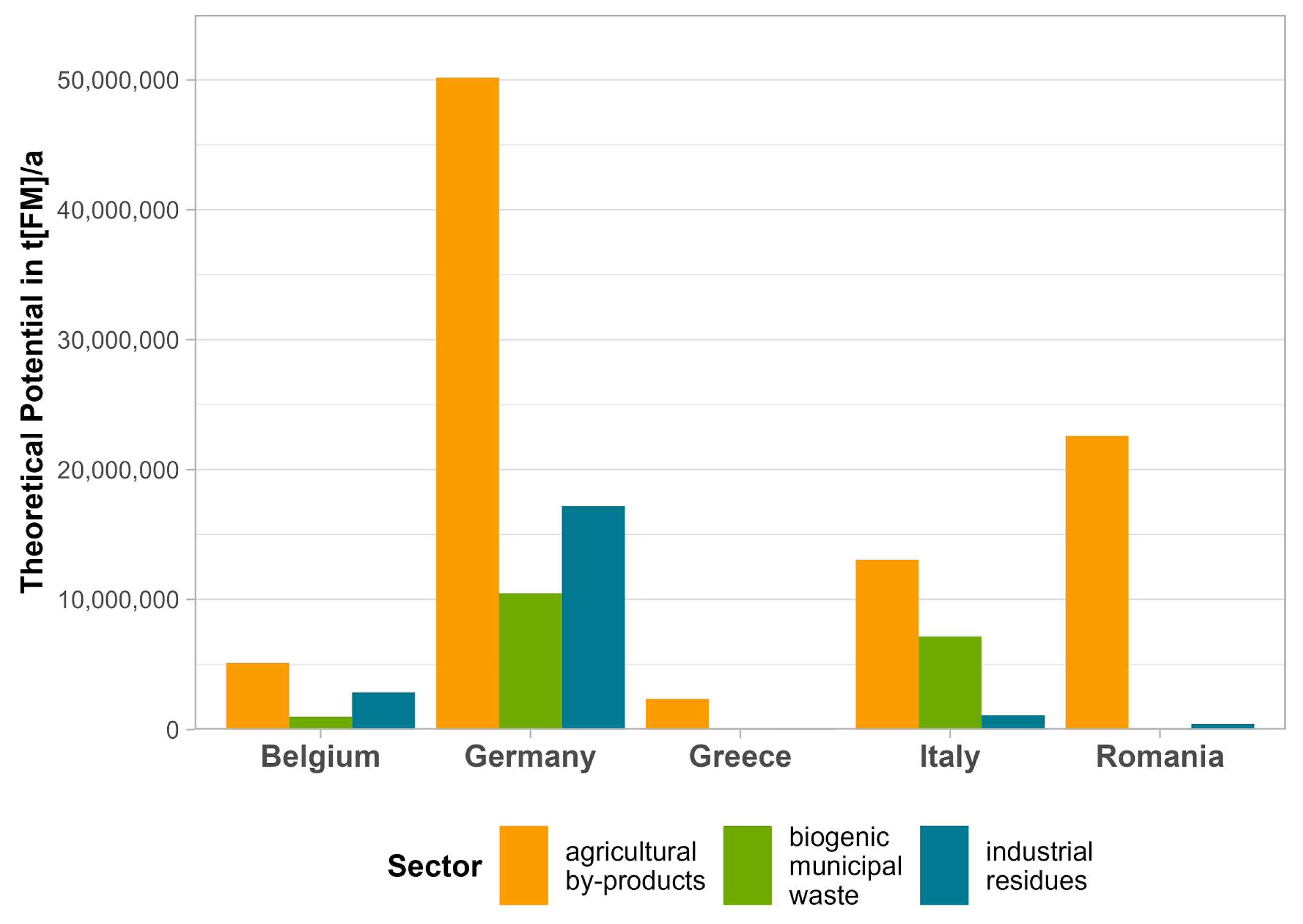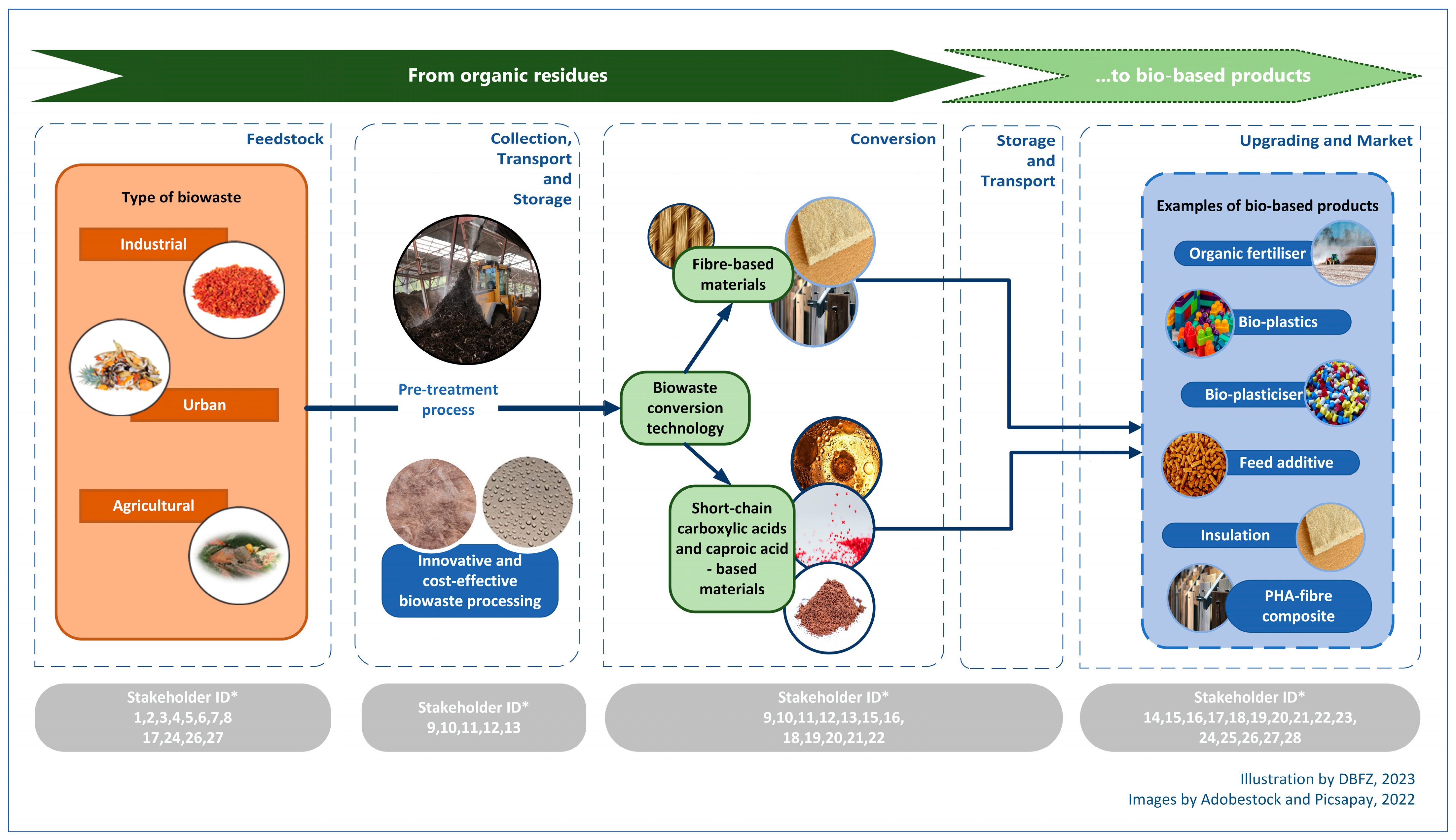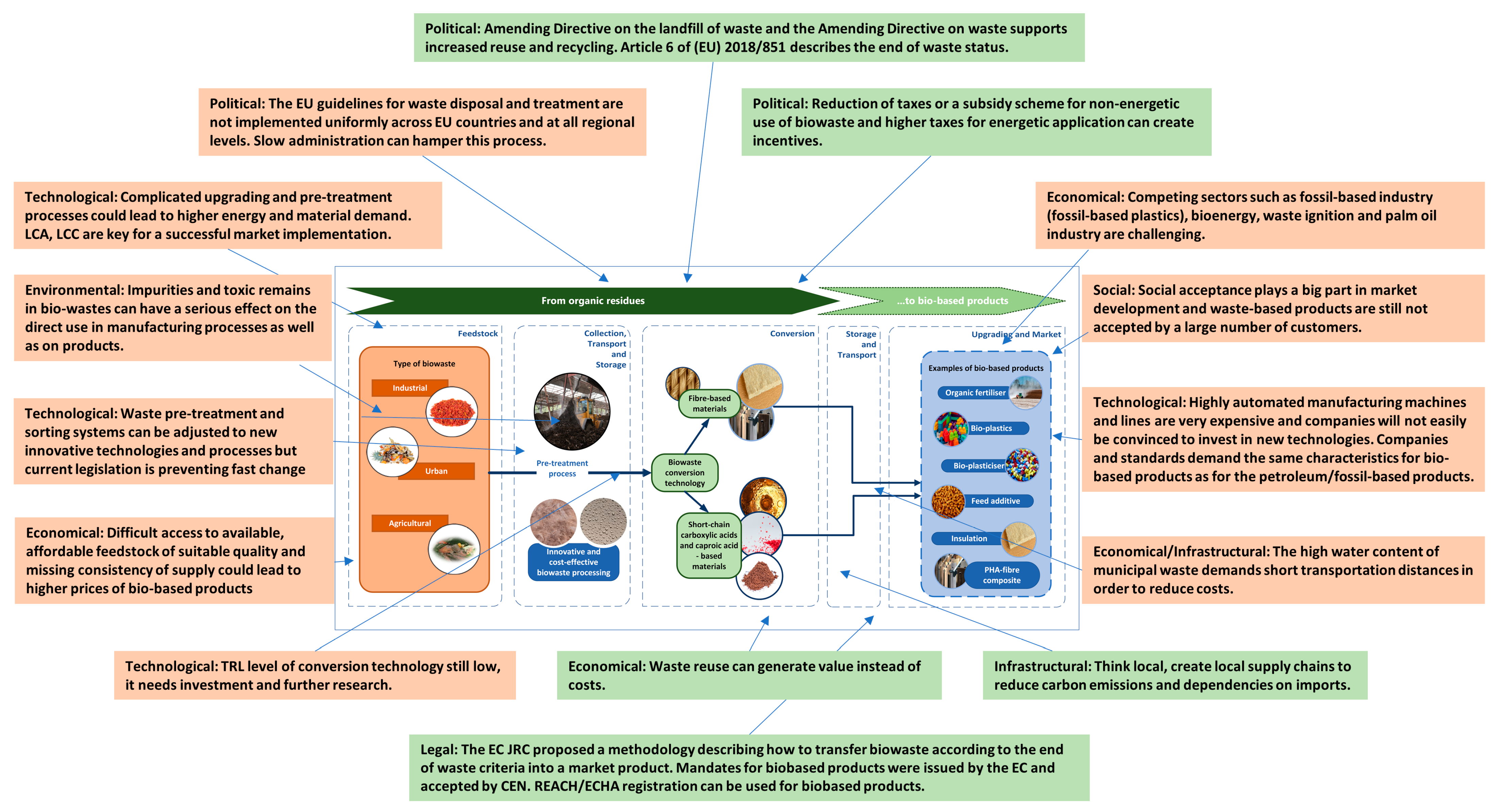Boosting Biowaste Valorisation—Do We Need an Accelerated Regional Implementation of the European Law for End-of-Waste?
Abstract
:1. Introduction
2. Materials and Methods
2.1. Analytical Approach
2.2. Data Collection
3. Results
PESTEL+I
- 1.
- Hindrances for the Biowaste Supply Chain
| PESTEL+I Categories | Hindrances (H) |
|---|---|
| Political |
|
| Economical |
|
| Social |
|
| Technological |
|
| Environmental |
|
| Legal |
|
| Infrastructural |
|
- 2.
- Enablers for the Biowaste Supply Chain
| PESTEL+I Categories | Enablers (E) |
|---|---|
| Political |
|
| Economical |
|
| Social |
|
| Technological |
|
| Environmental |
|
| Legal |
|
| Infrastructural |
|
4. Discussion
- Establish a regional regulatory framework to allow the creation of a market for biowaste products.
- Create a new category in waste legislation in Belgium for biowaste-based products.
- Form a task force at the regulatory authority (Wallonia: “Service Public de Wallonie (SPW)”) which should focus on biowaste-based products and the development of related legal criteria and detailed standards for end-of-waste processes.
- Form intersectoral associations of stakeholders and investors (food producers/feedstock, chemical industry/customers).
- Involve investors regardless of currently low TRL of the conversion technology and initiate joint follow-up upscaling feasibility projects.
- Create patents and green labels which will increase the credibility of the technology and products.
- Market the concept as a product portfolio, not only as single products.
- Invest in further R&D and upscaling and raise the TRL of the biowaste conversion technologies.
- Decrease production costs (with feedstock costs making up 60–70% of total production costs).
- Improve product performance to achieve competitiveness with fossil-based counterparts.
- Support and advocate for long-term validity of guidelines and accelerate introduction of standardisation guidelines at the local level.
- Explore further incentives in the EU emission trading system (EU ETS). Utilise the high carbon dioxide (CO2) price to stimulate market uptake.
- Adapt logistics, collection, storage and sorting systems to multiple demands of different industrial sectors.
- Use new artificial intelligence and digitalisation tools to create platforms that allow estimation of regionally available biowaste potentials and optimise logistics.
5. Conclusions
- Complex and unclear guidelines in different regions (e.g., in Belgium: Wallonia, Flanders, metropolitan Brussels) and EU member states hinder the implementation of the CAFIPLA concept in real markets and may deter interested companies.
- The industry is demanding that alternative resources and materials become more independent of external sources and fossil-based input. Joint activities between all associated stakeholders (municipalities, regional waste disposal, recycling and other companies) are required to take advantage of the situation and encourage policymakers and industry networks to create new circular concepts similar to CAFIPLA [17,21].
- The PESTEL+I analysis highlighted the most important factors which hinder or support a market shift, and recommendations were developed based on this. The most crucial step would be to create a new category in waste legislation in Wallonia as well as other Belgian regions for bio-based products.
Author Contributions
Funding
Institutional Review Board Statement
Informed Consent Statement
Data Availability Statement
Conflicts of Interest
References
- European Commission. European Green Deal: Delivering on Our Targets. Available online: https://ec.europa.eu/commission/presscorner/api/files/attachment/869807/EGD_brochure_EN.pdf.pdf (accessed on 19 June 2023).
- European Commission. A Sustainable Bioeconomy for Europe: Strengthening the Connection between Economy, Society and the Environment: Updated Bioeconomy Strategy. 2018. Available online: https://data.europa.eu/doi/10.2777/792130 (accessed on 20 May 2023).
- Andersson, J.O.; Lindroth, M. Ecologically unsustainable trade. Ecol. Econ. 2001, 37, 113–122. [Google Scholar] [CrossRef]
- Burritt, R.L.; Schaltegger, S. Measuring the (un-)sustainability of industrial biomass production and use. Sustain. Account. Manag. Policy J. 2012, 3, 109–133. [Google Scholar] [CrossRef]
- European Environment Agency. Bio-Waste in Europe: Turning Challenges into Opportunities. Available online: https://www.eea.europa.eu/publications/bio-waste-in-europe/download (accessed on 20 May 2023).
- European Commission. Guidance on Cascading Use of Biomass with Selected Good Practice Examples on Woody Biomass. Available online: https://data.europa.eu/doi/10.2873/68553 (accessed on 20 May 2023).
- World Economic Forum WEF. Project MainStream Urban Biocycles: System Initiative on Environment and Natural Resource Security. 2017. Available online: https://www3.weforum.org/docs/WEF_Project_MainStream_Urban_Biocycles_2017.pdf (accessed on 17 April 2023).
- Nordahl, S.L.; Devkota, J.P.; Amirebrahimi, J.; Smith, S.J.; Breunig, H.M.; Preble, C.V.; Satchwell, A.J.; Jin, L.; Brown, N.J.; Kirchstetter, T.W.; et al. Life-Cycle Greenhouse Gas Emissions and Human Health Trade-Offs of Organic Waste Management Strategies. Environ. Sci. Technol. 2020, 54, 9200–9209. [Google Scholar] [CrossRef] [PubMed]
- European Commission. EU Bioeconomy Strategy Progress Report: European Bioeconomy Policy: Stocktaking and Future Developments. Available online: https://op.europa.eu/o/opportal-service/download-handler?identifier=ae0a36d3-eac3-11ec-a534-01aa75ed71a1&format=pdf&language=en&productionSystem=cellar&part= (accessed on 20 May 2023).
- Chia, W.Y.; Chew, K.W.; Le, C.F.; Lam, S.S.; Chee, C.S.C.; Ooi, M.S.L.; Show, P.L. Sustainable utilization of biowaste compost for renewable energy and soil amendments. Environ. Pollut. 2020, 267, 115662. [Google Scholar] [CrossRef] [PubMed]
- Sakir, S.; Raman, S.N.; Safiuddin, M.; Amrul Kaish, A.B.M.; Mutalib, A.A. Utilization of by-products and wastes as supplementary cementitious materials in structural mortar for sustainable construction. Sustainability 2020, 12, 3888. [Google Scholar] [CrossRef]
- MUSIC. Deliverable D5.5—Set of Four Strategic Case Studies (Public Edition). Available online: https://www.music-h2020.eu/publications-reports/ (accessed on 20 July 2023).
- Jain, A.; Sarsaiya, S.; Kumar Awasthi, M.; Singh, R.; Rajput, R.; Mishra, U.C.; Chen, J.; Shi, J. Bioenergy and bio-products from bio-waste and its associated modern circular economy: Current research trends, challenges, and future outlooks. Fuel 2022, 307, 121859. [Google Scholar] [CrossRef]
- Joint Research Centre JRC. ENSPRESO—BIOMASS: Dataset. 2019. Available online: http://data.europa.eu/89h/74ed5a04-7d74-4807-9eab-b94774309d9f (accessed on 21 July 2022).
- Günther, S.; Karras, T.; Semella, S. Theoretical biomass potentials for EU 27. OpenAgrar 2023. [Google Scholar] [CrossRef]
- European Commission. Annual Production Series of Dairy Products: Milk Collection and Dairy Products Obtained, Production and Utilization of Milk on the Farm. Available online: https://agriculture.ec.europa.eu/system/files/2023-03/eu-dairy-historical-production-stocks-series_en.pdf (accessed on 24 April 2022).
- CAFIPLA. Deliverable D1.5—Final Report on the Market Assessment of CAP/FRP Based Bioproducts and CAFIPLA as Technology in the Bio-Economy Expansion. Available online: https://cafipla.eu/wp-content/uploads/2023/02/D1.5_Final-Market-Assessment.pdf (accessed on 20 June 2023).
- European Commission. A New Circular Economy Action Plan: For a Cleaner and More Competitive Europe. Available online: https://eur-lex.europa.eu/legal-content/EN/TXT/?qid=1583933814386&uri=COM:2020:98:FIN (accessed on 27 April 2023).
- Baldoni, E.; Philippidis, G.; Spekreijse, J.; Gurría, P.; Lammens, T.; Parisi, C.; Ronzon, T.; Vis, M.; M’Barek, R. Getting your hands dirty: A data digging exercise to unearth the EU’s bio-based chemical sector. Renew. Sustain. Energy Rev. 2021, 143, 110895. [Google Scholar] [CrossRef]
- Mahjoub, B.; Domscheit, E. Chances and challenges of an organic waste–based bioeconomy. Curr. Opin. Green Sustain. Chem. 2020, 25, 100388. [Google Scholar] [CrossRef]
- CAFIPLA Project Consortia. CAFIPLA Website: Objectives. Available online: https://cafipla.eu/home_cafipla/about/ (accessed on 7 November 2022).
- Service Public de Wallonie. Walloon Waste-Resources Plan. Non-Technical Summary of the Draft Plan. Available online: https://sol.environnement.wallonie.be/files/PWDR/WWRP-NTS-EN.pdf (accessed on 3 May 2023).
- Service Public de Wallonie. Génération de Déchets Ménagers et Assimilés. Available online: http://etat.environnement.wallonie.be/contents/indicatorsheets/MEN_9.eewGeneratePdf.do (accessed on 3 May 2023).
- Achinas, S.; Horjus, J.; Achinas, V.; Euverink, G.J.W. A PESTLE Analysis of Biofuels Energy Industry in Europe. Sustainability 2019, 11, 5981. [Google Scholar] [CrossRef]
- Blümel, L.; Siegfried, K.; Riedel, F.; Thrän, D. Are strategy developers well equipped when designing sustainable supply chains for a circular bio-economy?: Supporting innovations’ market uptake in a PESTEL+I environment. Energy Sustain. Soc. 2023. accepted. [Google Scholar]
- Siegfried, K.; Blümel, L.; Riedel, F.; Moosmann, D.; Cyffka, K.-F.; Richters, M.; Reumerman, P.; Vos, J.; Matisons, M.; Thrän, D. Plating the Hot Potato—How to Make Intermediate Bioenergy Carriers an Accelerator to a Climate Neutral Europe. 2023. Under Rev. Available online: https://www.researchsquare.com/article/rs-2025787/v1 (accessed on 1 January 2022).
- QSR International Pty Ltd. 2018. NVivo 1.6.1. Available online: https://www.qsrinternational.com/nvivo-qualitative-data-analysis-software/home (accessed on 1 January 2022).
- Directive (EU) 2018/850 of the European Parliament and of the Council of 30 May 2018 amending Directive 1999/31/EC on the landfill of waste. Off. J. Eur. Union 2018, 150, 100–130.
- European Union (EU). Directive (EU) 2018/851 of the European Parliament and of the Council of 30 May 2018 amending Directive 2008/98/EC on Waste; OJ L150/109; European Union: Brussels, Belgium, 2018; Available online: https://eur-lex.europa.eu/legal-content/EN/TXT/PDF/?uri=CELEX:32018L0851&rid=5 (accessed on 1 January 2022).
- Municipal Waste Europe. Summary of the Current EU Waste Legislation. Available online: https://www.municipalwasteeurope.eu/summary-current-eu-waste-legislation (accessed on 7 November 2022).
- Catarino, A.S.; Alejandro, V.; Litten, D.; Eder, P.; Luo, Z.; Delgado, L. End-of-Waste Criteria: Final Report. Available online: https://publications.jrc.ec.europa.eu/repository/bitstream/JRC53238/jrc53238.pdf (accessed on 20 June 2023).
- European Commission. EU Policy Framework on Biobased, Biodegradable and Compostable Plastics. Available online: https://environment.ec.europa.eu/topics/plastics/biobased-biodegradable-and-compostable-plastics_en (accessed on 4 November 2022).
- Regulation (EU) 2018/841 of the European Parliament and of the Council of 30 May 2018 on the Inclusion of Greenhouse Gas Emissions and Removals from Land Use, Land Use Change and Forestry in the 2030 Climate and Energy Framework, and Amending Regulation (EU) No 525/2013 and Decision No 529/2013/EU (Text with EEA Relevance). Available online: https://eur-lex.europa.eu/legal-content/EN/TXT/?uri=CELEX%3A32018R0841 (accessed on 1 January 2022).
- Ghi, T.; Webster, P.; Monzon, D.; Cheng, W.; Srisaard, P.; Lim, S.; Kolk, M.; Cheng, W.; Lim, P.S.S. Why the Biobased Materials Market Is Finally Poised for Growth. Available online: https://www.adlittle.com/en/insights/prism/why-bio-based-materials-market-finally-poised-growth (accessed on 4 November 2022).
- BioBasedEconomy. CEN/TC 411 Bio-Based Products. Available online: https://www.biobasedeconomy.eu/centc-411-bio-based-products/ (accessed on 7 November 2022).
- European Commission. A Lead Market Initiative for Europe: COM (2007) 860 Final. Available online: https://www.eea.europa.eu/policy-documents/a-lead-market-initiative-for-europe (accessed on 4 November 2022).
- BioBasedEconomy. Standardization in the Bio-Based Economy. Available online: https://www.biobasedeconomy.eu/standardization-2/ (accessed on 7 November 2022).
- European Chemicals Agency ECHA. Carboxylic Acids, C5-9. Available online: https://echa.europa.eu/en/substance-information/-/substanceinfo/100.065.141 (accessed on 7 November 2022).
- European Chemicals Agency ECHA. Biopol. Available online: https://echa.europa.eu/en/substance-information/-/substanceinfo/100.125.321 (accessed on 7 November 2022).
- European Chemicals Agency ECHA. Hexanoic Acid. Available online: https://echa.europa.eu/de/substance-information/-/substanceinfo/100.005.046 (accessed on 7 November 2022).
- Directive 2008/98/EC of the European Parliament and of the Council of 19 November 2008 on Waste and Repealing Certain Directives (Text with EEA Relevance). Available online: https://eur-lex.europa.eu/legal-content/EN/TXT/?uri=celex%3A32008L0098 (accessed on 1 January 2022).
- van Thuyne, G.; Gossens, F.; Environmental law and practice in Belgium: Overview. Global Guide 2015. Available online: https://content.next.westlaw.com/practical-law/document/I203078f01cb611e38578f7ccc38dcbee/Environmental-Law-and-Practice-in-Belgium-Overview?viewType=FullText&transitionType=Default&contextData=(sc.Default) (accessed on 1 January 2022).
- Yamakawa, C.K.; Qin, F.; Mussatto, S.I. Advances and opportunities in biomass conversion technologies and biorefineries for the development of a bio-based economy. Biomass Bioenergy 2018, 119, 54–60. [Google Scholar] [CrossRef]
- Giuntoli, J.; Bulgheroni, C.; Marelli, L.; Sala, S.; Pant, R.; Lusser, M.; Avraamides, M. Brief on the Use of Life Cycle Assessment (LCA) to Evaluate Environmental Impacts of the Bioeconomy; European Commission: Brussels, Belgium, 2019. [Google Scholar] [CrossRef]
- Kivimaa, P.; Boon, W.; Hyysalo, S.; Klerkx, L. Towards a typology of intermediaries in sustainability transitions: A systematic review and a research agenda. Resour. Policy 2019, 48, 1062–1075. [Google Scholar] [CrossRef]
- Kuckertz, E.S.C.; Berger, C.A.; Reyes, M. Entrepreneurial ventures and the bioeconomy. In Bioeconomy—Shaping the Transition to a Sustainable, Biobased Economy; Lewandowski, I., Ed.; Springer: Berlin/Heidelberg, Germany, 2018; pp. 273–284, Chapter 8. [Google Scholar]
- Slorach, P.C.; Jeswani, H.K.; Cuéllar-Franca, R.; Azapagic, A. Environmental and economic implications of recovering resources from food waste in a circular economy. Sci. Total Environ. 2019, 693, 133516. [Google Scholar] [CrossRef] [PubMed]
- Malinauskaite, J.; Jouhara, H.; Czajczyńska, D.; Stanchev, P.; Katsou, E.; Rostkowski, P.; Thorne, R.J.; Colón, J.; Ponsá, S.; Al-Mansour, F.; et al. Municipal solid waste management and waste-to-energy in the context of a circular economy and energy recycling in Europe. Energy 2017, 141, 2013–2044. [Google Scholar] [CrossRef]
- Friege, H.; Kummer, B.; Steinhäuser, K.G.; Wuttke, J.; Zeschmar-Lahl, B. How should we deal with the interfaces between chemicals, product and waste legislation? Environ. Sci. Eur. 2019, 31, 51. [Google Scholar] [CrossRef]
- Salmenperä, H.; Pitkänen, K.; Kautto, P.; Saikku, L. Critical factors for enhancing the circular economy in waste management. J. Clean. Prod. 2021, 280 Pt 1, 124339. [Google Scholar] [CrossRef]


| Stakeholder Group | Description | ID (Figure 2) |
|---|---|---|
| Feedstock suppliers | Waste treatment, waste handling and recycling company | 1 |
| Public waste disposal service | 2 | |
| Municipality | 3 | |
| Food industry, stores and producers | 4 | |
| Agricultural cooperatives | 5 | |
| Competitors for feedstocks | Biomass treatment and valorisation | 6 |
| Waste incineration | 7 | |
| Composting industry | 8 | |
| Plant operators | Regional economic development | 9 |
| Waste treatment, waste handling & recycling company | 10 | |
| Public waste disposal service | 11 | |
| Agricultural cooperatives | 12 | |
| Biogas plant operators | 13 | |
| Service providers | Incubators, regional innovation hub | 14 |
| Funding service for European research and innovation | 15 | |
| Environmental consulting company | 16 | |
| European Commission | 17 | |
| Society, research | Research institute agro-food/environment | 18 |
| Research institute for sustainable chemistry and environment | 19 | |
| Research institute for agricultural engineering and bioenergy | 20 | |
| Institute for technological research | 21 | |
| Agricultural research centre | 22 | |
| Politics | Ministry of the Environment, Nature, Forests, Rural Affairs and Animal Welfare | 23 |
| Waste authorities | 24 | |
| Other | Environmental and consumer protection authorities | 25 |
| Federation of waste management and environmental companies | 26 | |
| Waste management association | 27 | |
| Regional economic development office | 28 |
Disclaimer/Publisher’s Note: The statements, opinions and data contained in all publications are solely those of the individual author(s) and contributor(s) and not of MDPI and/or the editor(s). MDPI and/or the editor(s) disclaim responsibility for any injury to people or property resulting from any ideas, methods, instructions or products referred to in the content. |
© 2023 by the authors. Licensee MDPI, Basel, Switzerland. This article is an open access article distributed under the terms and conditions of the Creative Commons Attribution (CC BY) license (https://creativecommons.org/licenses/by/4.0/).
Share and Cite
Siegfried, K.; Günther, S.; Mengato, S.; Riedel, F.; Thrän, D. Boosting Biowaste Valorisation—Do We Need an Accelerated Regional Implementation of the European Law for End-of-Waste? Sustainability 2023, 15, 13147. https://doi.org/10.3390/su151713147
Siegfried K, Günther S, Mengato S, Riedel F, Thrän D. Boosting Biowaste Valorisation—Do We Need an Accelerated Regional Implementation of the European Law for End-of-Waste? Sustainability. 2023; 15(17):13147. https://doi.org/10.3390/su151713147
Chicago/Turabian StyleSiegfried, Konrad, Susann Günther, Sara Mengato, Fabian Riedel, and Daniela Thrän. 2023. "Boosting Biowaste Valorisation—Do We Need an Accelerated Regional Implementation of the European Law for End-of-Waste?" Sustainability 15, no. 17: 13147. https://doi.org/10.3390/su151713147
APA StyleSiegfried, K., Günther, S., Mengato, S., Riedel, F., & Thrän, D. (2023). Boosting Biowaste Valorisation—Do We Need an Accelerated Regional Implementation of the European Law for End-of-Waste? Sustainability, 15(17), 13147. https://doi.org/10.3390/su151713147










